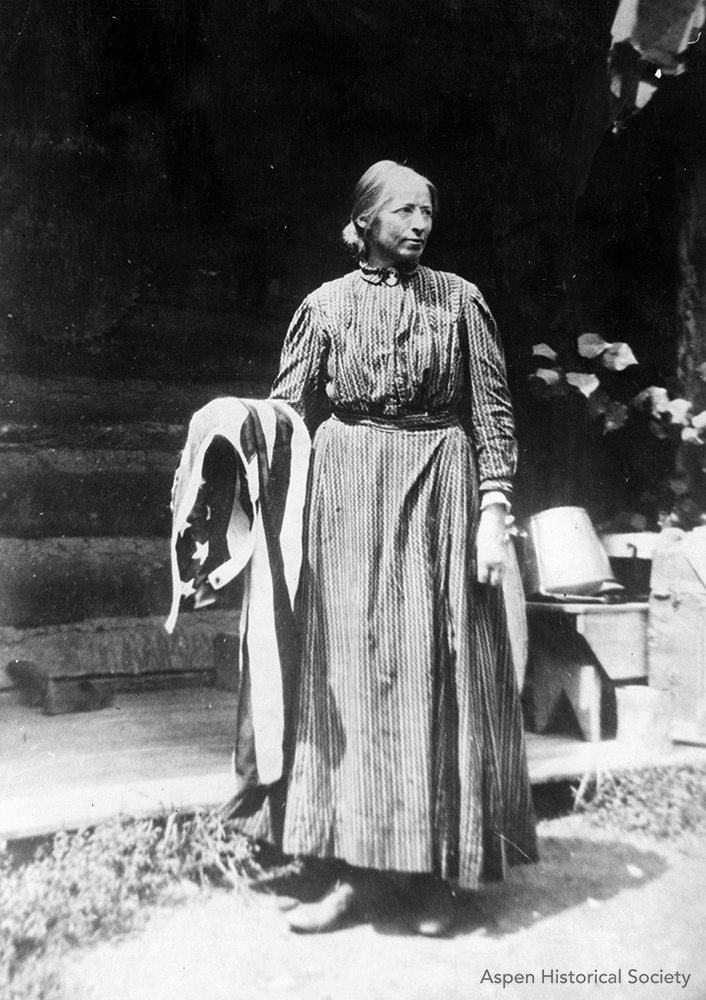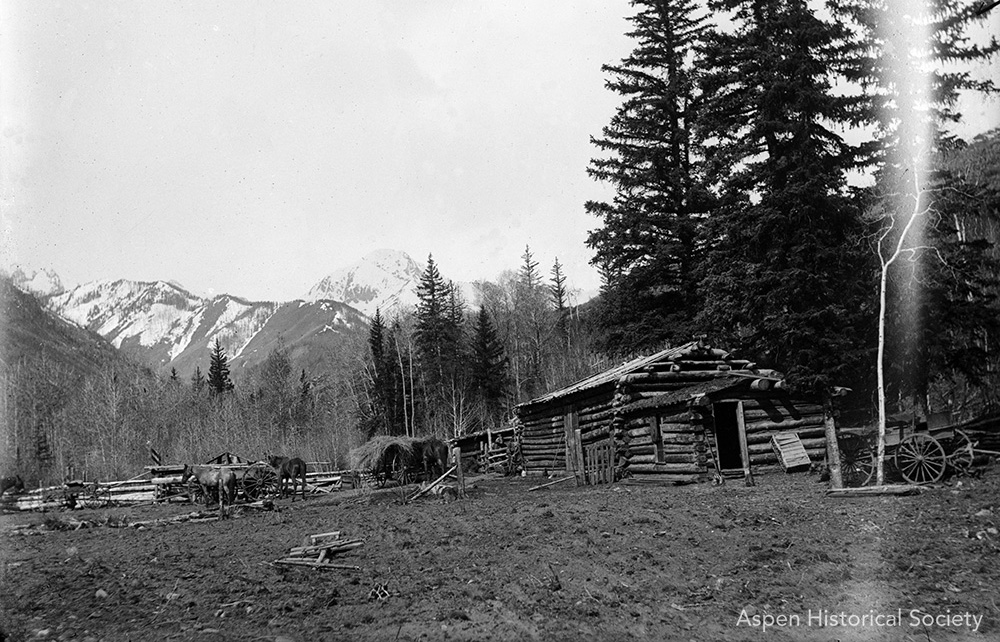Conserving the legacy of a true pioneer

Kate Lindvig, the “Cattle Queen of Snow Mass,” circa 1915. (Aspen Historical Society)
The recent acquisition of Snowmass Falls Ranch by Pitkin County Open Space and Trails is but the latest chapter in a story that began more than a century ago, when a Danish immigrant – a single woman, no less – established a ranch in the wilds of upper Snowmass Creek and became a local legend in the process.
Since March is Women’s History Month, established to commemorate and celebrate the vital role of women in American history, there’s no better time to tell the improbable story of Kate Lindvig. She was, by all accounts, a rugged individualist who earned the title “Cattle Queen of Snow Mass” – an apparent nod to both her gender and her business acumen.
Local newspapers bestowed the title early on, judging from a 1901 Aspen Tribune reference to Lindvig, the Cattle Queen. In February 1903, The Aspen Times offered this tidbit: “Kate Lindvig, the cattle queen of Snow Mass, visited the city yesterday and made arrangements to ship a mink and a wolf to the taxidermist at Glenwood which were caught on her property.”
But, we’re getting ahead of the story.
Kate was born Johanne Kathrine Jensen in 1864 in Borris, a small railroad town in central Denmark. One of nine children in a farm family, she followed an older sister to Copenhagen to attend college, but when her sweetheart emigrated to the United States, she saved the money her father sent for her schooling and followed her heart instead. Kate left Denmark at age 25 and apparently never looked back.
Lindvig’s story was recounted in a 1975 Aspen Times article by Mary Eshbaugh Hayes, as told by Gladyce Christiansen, wife of Kate’s nephew, and Kate’s friend Hildur Anderson, who grew up on a nearby ranch in what is now Snowmass Village.
Some accounts claim Lindvig wound up in Nebraska as a mail-order bride, but Christiansen said Kate headed to the Plains state intending to wed the beau she had known in Denmark. At any rate, she changed her mind and continued on to Colorado, changing her name to Lindvig because there were so many Jensens. Lindvig was the name of her father’s farm.
After a bout of typhoid fever on the Front Range that nearly killed her, Kate made her way to Aspen in 1891 at age 27. Kate got off the train, walked up Aspen’s Main Street, knocked on the door of the biggest house she saw and asked if they needed a cook, Christiansen recounted. She was hired. Kate saved her money and started a boarding house on East Hopkins where she put up miners. One of them couldn’t pay his bill and instead gave her his patented mining claim up Snowmass Creek to cover his room and board, according to family lore. In all, seven mining claims existed on what became Lindvig’s ranch, Pitkin County GIS mapping indicates.
Lindvig acquired the neighboring J.M. Tandy ranch in 1898 and then Clark G. Pennell’s property after his death in 1913. She also patented additional land to create the spread she dubbed Snowmass Falls Ranch.
Kate employed several out-of-work miners and tradesmen to help her run her operation, putting them up in a bunkhouse, and had a permit to run 80 head of Hereford cattle, according to Christensen. An Aspen girl, Marvel Jamison, was hired on as a maid and to assist with the chores. According to one newspaper account, Jamison was injured when a spooked horse overturned the wagon that Kate and Jamison were taking to town.
Kate sold meat and other products from her ranch in town, transporting them by wagon or sled and hauling supplies back to her ranch. Hildur (Hoaglund) Anderson, then a youngster, remembered Kate stopping by her family’s ranch on Brush Creek and sometimes spending the night.
“She would come on horseback in the worst storms. It was a lonely life out there. I don’t know what I would have done without her good friendship,” Anderson said. Kate was an intelligent woman who encouraged Anderson to get an education and brought her newspapers to read. Kate loved to read the stock market reports, according to Anderson, who became a well-loved local schoolteacher.
Descriptions of Kate suggest she was a hard-working and savvy business woman. Charles Grover, whose father was a proprietor at the Gould Store (later the Mesa Store) on Main Street in Aspen, claimed his father would raise his prices when he saw Kate coming so that by the time they finished haggling, he could sell her goods at the regular price (“The People of Aspen and the Roaring Fork Valley,” by Anne Gilbert, for the Aspen Historical Society, November 1991).
In 1908, when the State Agricultural College offered the Farmers’ Short Course in Aspen, plus a Domestic Science Class for homemakers, the Aspen Times Daily made much of the fact that Lindvig was the only woman to sign up for the farming course, though she purchased a ticket for the domestic science course, as well.
It was during this period that James H. Adams, superintendent of Aspen schools, took a photograph of Kate at her ranch, circa 1914. Miraculously, it and other photographs he took in the area were discovered in the possession of his daughter in Washington state in 1951. The remarkable image brings the determined Cattle Queen to life in a way that mere words cannot.
In the 1920s, Kate expanded into the outfitting business, renting furnished cabins to outdoorsmen and their families, cooking meals and providing horseback excursions to Snowmass Lake. She added more cabins as the business grew, according to Gladyce Christiansen. Parties enjoying the amenities at Kate’s ranch earned mentioned in the local papers.
So enthralled by a 1929 visit to the ranch and lake was a visitor from Cincinnati that he gushed about it in the Cincinnati Times-Star, describing Kate as “a Danish woman of surprising comprehension of humanity and world affairs.” The Aspen Times reprinted the article.
In 1933, Kate deeded easements across her property to the White River National Forest for both the Snowmass Lake and West Snowmass trails.
Kate never married (not that there weren’t offers, Christensen said), but she did have family here. Her sister, Sophia, and her husband, Mads Christensen, came from Denmark with their six children in 1914. They leased some of her land and later acquired the Glendale Stock Farm on Owl Creek Road.
Kate eventually moved to the Glendale farm and, in 1943, sold her ranch to Bob Perry, his wife Ruth Brown Perry, and Ruth’s brother, D.R.C. Brown, Jr. Bob and Ruth Perry became the sole owners in the early 1950s. The Perry family remained stewards of Snowmass Falls Ranch for 80 years.
In 1946, Kate moved to San Diego to live with relatives and then in the care of a nursing home. She was nearly 97 years old when she died Feb. 1, 1957.
Her legacy lives on in Snowmass Falls Ranch.
– By Pitkin County Open Space and Trails

A log building and corrals at Snowmass Falls Ranch, circa 1910. (Aspen Historical Society, Masterson Estate Collection)
